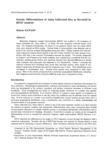Genetic Differentiation of Asian Cultivated Rice as Revealed by RFLP Analysis
JIRCAS international symposium series
| ISSN | 13406108 |
|---|---|
| 書誌レコードID(総合目録DB) | AA1100908X |

本文フルテキスト
intlsymp-2_81-87.pdf250.96 KB
Restriction Fragment Length Polymorphism (RFLP) was studied in 135 accessions of Asian cultivated rice, Oryza sativa L., of which 123 were landraces collected mainly from Asia. For Southern hybridization, 56 clones of rice genomic library and one maize cDNA clone were selected as DNA probes. Various kinds of polymorphism were detected, and almost all the cultivars could be distinguished from each other. Cluster analysis (CA) and principal component analysis (PCA) applied to the RFLP data revealed two major groups of landraces, with only a few cultivars intermediate between the groups. The groups, designated as clusters I and II based on the cluster analysis, were considered to correspond with the conventional varietal groups (lndica and Japonica), because they showed differences in phenol color reactions, Est 3 genotypes and responses to low temperature. Cluster I contained the cultivars collected from Southeast Asia, South Asia and their vicinity, while cluster II consisted of those from Southeast Asia and the temperate zone of Asia. Their distribution areas overlapped in Southeastern Asia. Several minor groups were recognized in each major group. Most of the smaller groups showed a particular geographical distribution, indicating that indigenous landraces had evolved in different areas over a long period of time.
| 作成者 | Makoto KAWASE |
|---|---|
| 公開者 | Japan International Research Center for Agricultural Sciences |
| オンライン掲載日 | |
| 号 | 2 |
| 開始ページ | 81 |
| 終了ページ | 87 |
| 言語 | eng |
